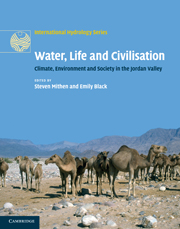Book contents
- Frontmatter
- Contents
- List of figures
- List of tables
- List of contributors
- Acknowledgements
- 1 Introduction: an interdisciplinary approach to Water, Life and Civilisation
- Part I Past, present and future climate
- Part II The palaeoenvironmental record
- Part III Hydrological studies of the Jordan Valley
- Part IV Human settlement, climate change, hydrology and water management
- Part V Palaeoeconomies and developing archaeological methodologies
- 20 The reconstruction of diet and environment in ancient Jordan by carbon and nitrogen stable isotope analysis of human and animal remains
- 21 Irrigation and phytolith formation: an experimental study
- 22 An investigation into the archaeological application of carbon stable isotope analysis used to establish crop water availability: solutions and ways forward
- 23 Past plant use in Jordan as revealed by archaeological and ethnoarchaeological phytolith signatures
- Part VI Society, economy and water today
- Part VII Conclusions
- Index
- Plate section
- References
22 - An investigation into the archaeological application of carbon stable isotope analysis used to establish crop water availability: solutions and ways forward
from Part V - Palaeoeconomies and developing archaeological methodologies
Published online by Cambridge University Press: 26 April 2011
- Frontmatter
- Contents
- List of figures
- List of tables
- List of contributors
- Acknowledgements
- 1 Introduction: an interdisciplinary approach to Water, Life and Civilisation
- Part I Past, present and future climate
- Part II The palaeoenvironmental record
- Part III Hydrological studies of the Jordan Valley
- Part IV Human settlement, climate change, hydrology and water management
- Part V Palaeoeconomies and developing archaeological methodologies
- 20 The reconstruction of diet and environment in ancient Jordan by carbon and nitrogen stable isotope analysis of human and animal remains
- 21 Irrigation and phytolith formation: an experimental study
- 22 An investigation into the archaeological application of carbon stable isotope analysis used to establish crop water availability: solutions and ways forward
- 23 Past plant use in Jordan as revealed by archaeological and ethnoarchaeological phytolith signatures
- Part VI Society, economy and water today
- Part VII Conclusions
- Index
- Plate section
- References
Summary
ABSTRACT
Carbon stable isotope analysis of charred cereal remains is a relatively new method employed by archaeological scientists to investigate ancient climate and irrigation regimes. The aim of this study was to assess the effect of environmental variables on carbon isotope discrimination (Δ) in multiple environments to develop the technique and its archaeological application, using crops grown at three experimental stations in Jordan. There are two key results: (1) as expected, there was a strong positive relationship between water availability and Δ; (2) site, not water input, was the most important factor in determining Δ. Future work should concentrate on establishing ways of correcting Δ for the influence of site specific environmental variables and on assessing how well carbon isotope discrimination values are preserved within the archaeological record.
INTRODUCTION
Carbon stable isotope analysis of archaeological cereals is a relatively new approach for the investigation of ancient irrigation systems (Araus and Buxo, 1993; Araus et al., 1997b; Ferrio et al., 2005; Araus et al., 2007; Riehl et al., 2008). The approach relies on the basic principle that plants under water stress discriminate less against the ‘heavier’ carbon-13 (13C) isotope than plants whose water requirements are fully met (Farquhar and Richards, 1984; Farquhar et al., 1989). As a consequence, the tissues of water-stressed plants contain more 13C than those which have received sufficient water through rainfall or irrigation.
- Type
- Chapter
- Information
- Water, Life and CivilisationClimate, Environment and Society in the Jordan Valley, pp. 373 - 380Publisher: Cambridge University PressPrint publication year: 2011
References
- 8
- Cited by



